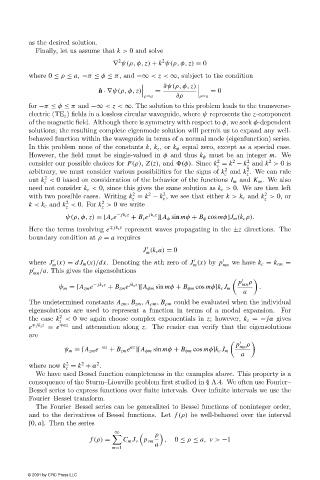Page 508 - Electromagnetics
P. 508
as the desired solution.
Finally, let us assume that k > 0 and solve
2
2
∇ ψ(ρ, φ, z) + k ψ(ρ, φ, z) = 0
where 0 ≤ ρ ≤ a, −π ≤ φ ≤ π, and −∞ < z < ∞, subject to the condition
∂ψ(ρ, φ, z)
= = 0
ˆ n ·∇ψ(ρ, φ, z)
ρ=a ∂ρ ρ=a
for −π ≤ φ ≤ π and −∞ < z < ∞. The solution to this problem leads to the transverse-
electric (TE z ) fields in a lossless circular waveguide, where ψ represents the z-component
of the magnetic field. Although there is symmetry with respect to φ, we seek φ-dependent
solutions; the resulting complete eigenmode solution will permit us to expand any well-
behaved function within the waveguide in terms of a normal mode (eigenfunction) series.
In this problem none of the constants k, k z ,or k φ equal zero, except as a special case.
However, the field must be single-valued in φ and thus k φ must be an integer m.We
2
2
2
2
consider our possible choices for P(ρ), Z(z), and #(φ). Since k = k − k and k > 0 is
c z
2
2
arbitrary, we must consider various possibilities for the signs of k and k . We can rule
z
c
2
out k < 0 based on consideration of the behavior of the functions I m and K m . We also
c
need not consider k c < 0, since this gives the same solution as k c > 0. We are then left
2
2
2
2
with two possible cases. Writing k = k − k , we see that either k > k c and k > 0,or
z
c
z
2
2
k < k c and k < 0.For k > 0 we write
z
z
ψ(ρ, φ, z) = [A z e − jk z z + B z e jk z z ][A φ sin mφ + B φ cos mφ]J m (k c ρ).
Here the terms involving e ∓ jk z z represent waves propagating in the ±z directions. The
boundary condition at ρ = a requires
J (k c a) = 0
m
where J (x) = dJ m (x)/dx. Denoting the nth zero of J (x) by p we have k c = k cm =
m m mn
p /a. This gives the eigensolutions
mn
p ρ
− jk z z jk z z mn
ψ m = [A zm e + B zm e ][A φm sin mφ + B φm cos mφ]k c J m .
a
The undetermined constants A zm , B zm , A ρm , B ρm could be evaluated when the individual
eigensolutions are used to represent a function in terms of a modal expansion. For
2
the case k < 0 we again choose complex exponentials in z; however, k z =− jα gives
z
e ∓ jk z z = e ∓αz and attenuation along z. The reader can verify that the eigensolutions
are
p ρ
αz
−αz
mn
ψ m = [A zm e + B zm e ][A φm sin mφ + B φm cos mφ]k c J m
a
2
2
2
where now k = k + α .
c
We have used Bessel function completeness in the examples above. This property is a
consequence of the Sturm–Liouville problem first studied in § A.4. We often use Fourier–
Bessel series to express functions over finite intervals. Over infinite intervals we use the
Fourier–Bessel transform.
The Fourier–Bessel series can be generalized to Bessel functions of noninteger order,
and to the derivatives of Bessel functions. Let f (ρ) be well-behaved over the interval
[0, a]. Then the series
∞
ρ
f (ρ) = C m J ν p νm , 0 ≤ ρ ≤ a,ν > −1
a
m=1
© 2001 by CRC Press LLC

